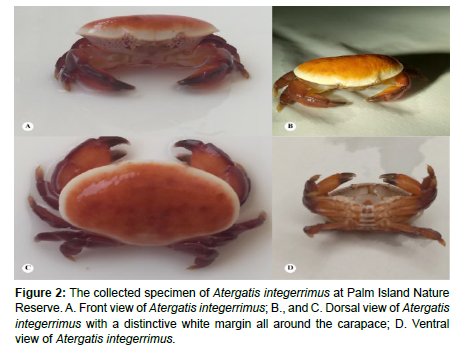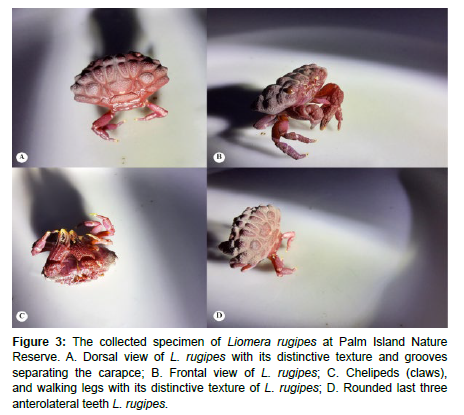Expanding Boundaries: Documenting Two Xanthid Crabs (Atergatis integerrimus and Liomera rugipes) in the Mediterranean Sea from Lebanese Waters
Received: 02-Aug-2024 / Manuscript No. jflp-24-145870 / Editor assigned: 05-Aug-2024 / PreQC No. jflp-24-145870 / Reviewed: 19-Aug-2024 / QC No. jflp-24-145870 / Revised: 22-Aug-2024 / Manuscript No. jflp-24-145870 / Published Date: 30-Aug-2024 DOI: 10.4172/2332-2608.1000561
Short Communication
The red egg crab, Atergatis integerrimus (Lamarck, 1818), and Liomera rugipes (Heller, 1860) are both species belonging to the family Xanthidae MacLeay, 1838, which comprises 170 genera and approximately 760 species [1]. These two species are originally from the Indo-Pacific region [2-5]. Notably, Atergatis integerrimus has never been reported in the Mediterranean Sea, marking its absence in the scientific literature concerning this region. In contrast, Liomera rugipes was recently recorded in the Mediterranean, specifically in Egyptian waters, suggesting a possible range expansion or introduction into this new environment [5]. To this date, six Non-Indigenous Species (NIS) from the family Xanthidae have been recorded in the Mediterranean Sea. Five of these species are of Indo-Pacific origin: Actaea savignyi (H. Milne Edwards, 1834), Actaeodes tomentosus (H. Milne Edwards, 1834), Atergatis roseus (Rüppell, 1830), Liomera rugipes (Heller, 1860), and Xanthias lamarckii (H. Milne Edwards, 1834). The sixth species, Dyspanopeus sayi (Smith, 1869), is of Atlantic origin [5].
In the Lebanese waters, eight species of the family Xanthidae have been documented. Six of these are indigenous: Microcassiope minor (Dana, 1852), Xantho hydrophilus (Herbst, 1790) cited as Xantho incisus (Leach, 1814), Xantho granulicarpus Forest, 1953, and Xantho poressa (Olivi, 1792). The other two species, Actaea savignyi (H. Milne Edwards, 1834) and Atergatis roseus (Rüppell, 1830), are non-indigenous Lessepsian migrants [6-9]. In this context, this study aims to report the red egg crab Atergatis integerrimus for the first time in the Mediterranean Sea, specifically from the Lebanese waters, and to document the presence of Liomera rugipes for the first time in the Lebanese waters and the second time in the Mediterranean Sea. On July 3, 2024, during a routine daily monitoring trip conducted by the team of Palm Islands Nature Reserve, situated in northern Lebanon (Figure 1), two previously unrecorded species of crabs were observed and photographed at a depth of 3 meters within the rocky areas of the reserve (34°29'45"N; 35°46'31"E). Upon discovery, the team promptly contacted one of us (SM) for further identification and verification. Detailed photographs and videos of the crabs were shared, and samples of each species were carefully collected and preserved for further examination. The samples were stored under the codes PINR03 and PINR04, respectively, at the Palm Islands Nature Reserve for future reference and study. Based on Sérène 1985, the two collected specimens were morphologically described. Atergatis integerrimus measured approximately 3 cm in body length. This species is easily recognized by its distinctive suboval, transverse carapace with a smooth surface that lacks granules or ridges (Figure 2A, 2B, 2C, 2D). The carapace exhibits a red to brownish coloration with white spots on the body (Figure 2A), further distinguished by a prominent and clearly defined white margin that encircles the entire carapace (Figure 2B, 2C), making it a visually striking species. Morphologically, the specimen collected from Lebanese waters closely resembles to those previously collected in Indian (Indo-Pacific) waters see (Figure 1) in [10]. The collected specimen of Liomera rugipes measured approximately 2 cm in body length. It is distinguished by the distribution and form of the grooves separating the regions of the reddish carapace (Figure 2A, 2B). Additionally, the general groove pattern in L. rugipes is characterized by a coarsely rough texture on its anterolateral carapace regions, chelipeds (claws), and walking legs (Figure 2C). The combination of these specific carapace grooves and the coarse texture of the appendages makes Liomera rugipes readily identifiable among other species in its genus (see Planche IV-D in Sérène, 1984). Another distinctive morphological feature is the last three anterolateral teeth, which are rounded (Figure 2A and 2D). Notably, the specimen collected from Lebanese waters bears a strong resemblance to those previously collected in Egyptian waters (see Figure 1 in Nour et al., 2023) [5]. In addition to the morphological observations, it is important to note that the identification of Liomera rugipes would benefit from genetic analysis to confirm its taxonomic status and better understand its phylogenetic relationships within the Xanthidae family. The current record of Atergatis integerrimus represents the first documentation of this species in the Mediterranean Sea, bringing the total number of NIS Xanthid in the Mediterranean to seven, three of which have been found in Lebanese waters. Meanwhile, the record of Liomera rugipes marks the second occurrence of this species in the Mediterranean, following its initial observation in Egyptian waters, indicating an expansion of its range within the basin [5].
Figure 3: The collected specimen of Liomera rugipes at Palm Island Nature Reserve. A. Dorsal view of L. rugipes with its distinctive texture and grooves separating the carapce; B. Frontal view of L. rugipes; C. Chelipeds (claws), and walking legs with its distinctive texture of L. rugipes; D. Rounded last three anterolateral teeth L. rugipes.
The introduction of Atergatis integerrimus and Liomera rugipes into the Mediterranean Sea is likely linked to their migration from the Red Sea. However, the exact pathway of their arrival in Lebanon and the broader Mediterranean remains uncertain, it is highly plausible that these species spread naturally through the Suez Canal, particularly Liomera rugipes as suggested by Nour OM. In addition, Lebanon lies along the natural pathway for Indo-Pacific taxa entering the Mediterranean via prevailing currents, making it a likely area for the spread of these species.Regardless of the exact pathway, the fact that both species are toxic [11] and small, with cryptic habits that make them difficult to observe in rocky areas (Sérène, 1984), highlights the pressing need to evaluate their current status as NIS in Lebanese waters and the Mediterranean, as well as their impacts on local benthic communities.
References
- Mendoza JC, Chan KO, Lai JC, Thoma BP, Clark PF et al. (2022) A comprehensive molecular phylogeny of the brachyuran crab superfamily Xanthoidea provides novel insights into its systematics and evolutionary history. Molecular Phylogenetics and Evolution, 177, 107627.
- Serène R (1984) Crustacés Décapodes Brachyoures de l'océan Indien occidental et de la mer Rouge, Xanthoidea: Xanthidae et Trapeziidae. Avec un addendum par Crosnier A: Carpiliidae et Menippidae. Faune tropicale, 24: 1-243.
- Galil B, Vannini M (1990) Research on the coast of Somalia. Xanthidae Trapeziidae Carpiliidae Menippidae (Crustacea Brachyura). Tropical Zoology 3: 21-56.
- Karim RM, Al-Khafaji KK, Yaseen AT, Mutlak FM (2022) First occurrence of two crab species, Actaea calculosa (Milne Edwards, 1834) and Atergatis integerrimus (Lamarck, 1801), family Xanthidae in Iraqi coast waters. Egyptian Journal of Aquatic Biology & Fisheries, 26.
- Nour OM, ZavaB, Corsini-Foka MARIA (2023). Liomera rugipes (Heller, 1861) (Brachyura: Xanthidae: Liomerinae): a new Indo-West Pacific crab in the Mediterranean Sea, Egypt. Mediterranean Marine Science, 24: 510-513.
- Shiber JG (1981) Brachyurans from Lebanese waters. Bulletin of Marine Science, 31: 864-875.
- BITAR G (1996) Le macrozoobenthos. in: Etude de la biodiversité biologique du Liban.Pub.5: Faune et flore marines et côtières. Projet GF/ 6105-92-72. Minist Agr Liban, PNUE: 41-48, Tab.22: 113-126.
- Lakkis S (2013) Le zooplancton marin du Liban (Méditerranée orientale). Biologie, Biodiversite, Biogeographie. Aracne, Roma, 510 pp.
- Crocetta F, Agius D, Balistreri P, Bariche M, BayhanY et al.(2015) New Mediterranean Biodiversity Records (October 2015). Mediterranean Marine Science 16: 682-702.
- Thanamalini R ,Shyla Suganthi A (2018) Morphometric Analysis Of The Crab, Atergatis Integerrimus (Lamarck, 1818) (Decapoda, Brachyura, Xanthidea). International Journal of Zoology and Applied Biosciences, 3: 48-56.
- Fredrick WS, Ravichandran S, Balasubramanian T (2011) Toxicity of Brachuryan crabs in India. Toxicological & Environmental Chemistry 93: 406-411.
Indexed at, Google Scholar, Crossref
Citation: Fatfat S, Badreddine A, Aguilar R (2024) Expanding Boundaries: Documenting Two Xanthid Crabs (Atergatis integerrimus and Liomera rugipes) in the Mediterranean Sea from Lebanese Waters. J Fisheries Livest Prod 12: 561. DOI: 10.4172/2332-2608.1000561
Copyright: © 2024 Fatfat S, et al. This is an open-access article distributed under the terms of the Creative Commons Attribution License, which permits unrestricted use, distribution, and reproduction in any medium, provided the original author and source are credited.
Select your language of interest to view the total content in your interested language
Share This Article
Recommended Journals
Open Access Journals
Article Tools
Article Usage
- Total views: 1826
- [From(publication date): 0-2024 - Nov 13, 2025]
- Breakdown by view type
- HTML page views: 1528
- PDF downloads: 298



